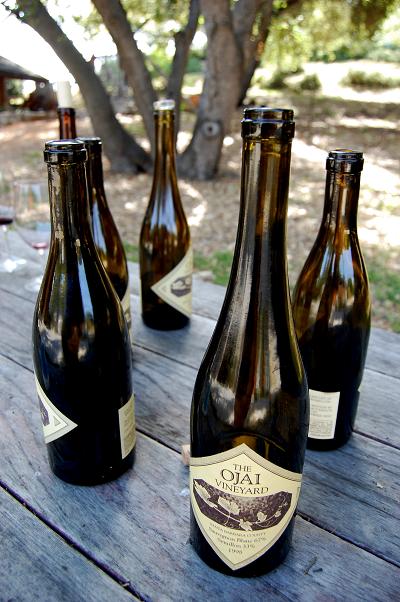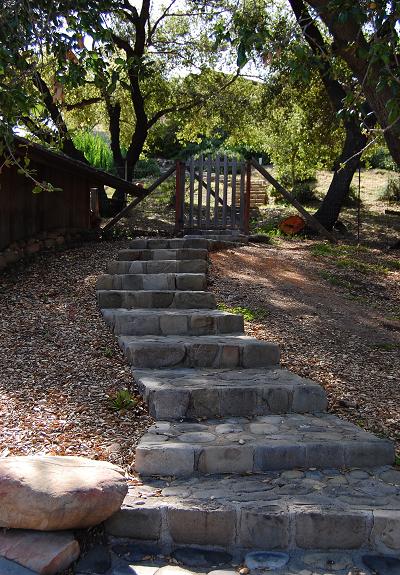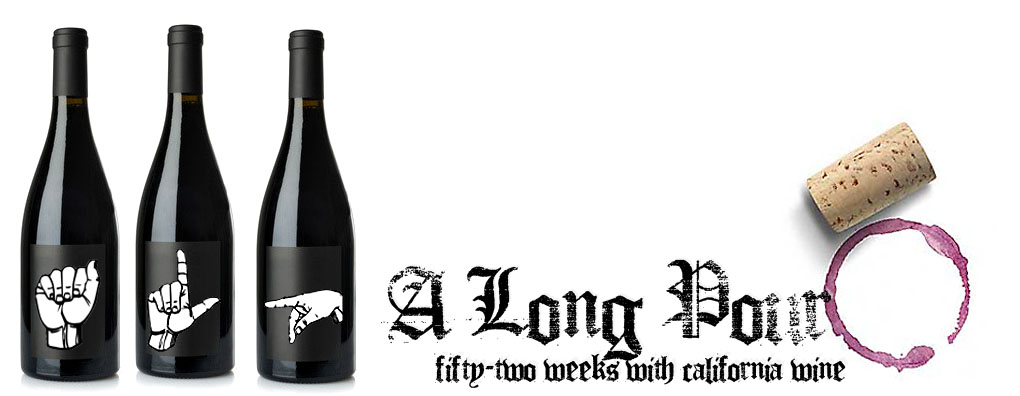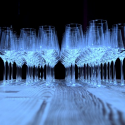The Ojai Vineyard – Part II
Two weeks ago I wrote about The Ojai Vineyard and my time with Adam Tolmach and Fabien Castel. Much of the story centered on Adam’s decision to tone back the amount of alcohol in some of his wines over the past several years. At the outset, I did not intend to write a story that focused so heavily on the controversy that came along with his decision. Nor did I plan on writing so extensively about his relationship with wine critics (one in particular). These topics just became a big part of our conversation that day.
Yet, I am pleased I wrote it. In preparing for my interview with Adam, I came across much chatter about him. Some was in praise of the winemaker and some was not. A small portion of it was borderline character assassination. Therefore, I was happy to present Adam’s fair and balanced side of the story.
Read the original interview here: The Ojai Vineyard: “Legends, Myths, and Fantastic Chardonnay”.
 As debate generally goes, it is easy to get hung up over-analyzing details or arguing moot points, especially when it comes to artistic discretion. It is the same for any medium where the product is subjective according to personal taste. Take for example, a painting. While it may be pleasant to look at, some are driven to go deeper then a simple like or dislike of the work. They are compelled to get at the “deeper meaning”, asking questions such as, “what did the artist mean by that stroke there? Why the dominant use of blues and gray? Does the orange tree in the distance symbolize his longing to attain youth and his despair that life is utterly vain and pointless?” We can get so caught up with our own interpretations that we entirely miss the painter standing right behind us, as if waiting to say, “excuse me, but I can explain what that means and why I did it, if you care to listen.” We can imagine grand, opulent explanations of metaphors, and deep spiritual symbolism, but sometimes the answers are as simple as, “I just like oranges.”
As debate generally goes, it is easy to get hung up over-analyzing details or arguing moot points, especially when it comes to artistic discretion. It is the same for any medium where the product is subjective according to personal taste. Take for example, a painting. While it may be pleasant to look at, some are driven to go deeper then a simple like or dislike of the work. They are compelled to get at the “deeper meaning”, asking questions such as, “what did the artist mean by that stroke there? Why the dominant use of blues and gray? Does the orange tree in the distance symbolize his longing to attain youth and his despair that life is utterly vain and pointless?” We can get so caught up with our own interpretations that we entirely miss the painter standing right behind us, as if waiting to say, “excuse me, but I can explain what that means and why I did it, if you care to listen.” We can imagine grand, opulent explanations of metaphors, and deep spiritual symbolism, but sometimes the answers are as simple as, “I just like oranges.”
When I interview winemakers or General Managers, the settings and circumstances vary greatly. At times, we have enjoyed the company of small groups of individuals who were also visiting the winery. Such was the case at The Ojai Vineyard. I mention this because it shapes the way the interviews are done and how they develop when others are present. Prior to the arrival of the other two guests, who joined us for a tasting under one of Adam’s massive oak trees, we openly discussed much of what appeared in the previous article: wine trends and critics. While I would’ve normally gone deeper into Adam’s personal history with wine, I did not want to dominate the conversation with question after question. After all, wine should spark conversation. So in short, I did not get as much recorded on some of the philosophy behind The Ojai Vineyard as I did with some of the topics listed above. Yet, we had a great conversation with plenty to pull from.
So what I offer now is a first for A Long Pour, a Part II…a second look at what The Ojai Vineyard does and why they do it. What their “oranges” mean to them.
The story of The Ojai Vineyard and its relevance to fans of California Rhone wines was well pointed out by one of the guests that day. Two men about Adam’s age joined us from Santa Barbara. One of the gentlemen who spent much time touring and tasting in France as well as throughout California (he also made wine from home for a period in the 70’s) commented that the experience tasting with Adam was similar to his experiences tasting in France. There is genuineness to sitting with a winemaker and listening to him talk about the different vintages, the unique challenges they offered, and how he chose to respond to them. I contacted the gentlemen a few days after we met. He told me in email that he “found listening to [Adam] as satisfying as trying his wines. Wild yeast; no tasting room; cannot buy wine at the winery…” He concluded that Adam “was the one with soul.” I had already been considering a second edition of the Ojai story, but this sentence convinced me I should. Adam is the real deal.
A picnic bench was our open air tasting room, in front of us a decade’s worth of wine. The only sounds other than our conversation and the occasional punctuation of a cork popping were from various birds and the gentle rustle of the wind through the trees. Adam has a cozy home with stone steps that lead down to an open concrete area flanked on either side by small wooden barn structures where he and his two assistants make their wine. While Adam entertains the occasional wine writer or critic that stops by, the winery is not open to the public. There are no grand fountains or helipads. He does not have a herd of wild zebra that roam the Ojai Valley property (none that we saw anyway) or marbled lions that line his dirt and gravel drive way. We met his sons, played with his dog, and enjoyed a little piece of what it’s like to make wine at The Ojai Vineyard.
The serene, unassuming surroundings perfectly reflect Adam’s personality and his gentle demeanor. He speaks calmly, thoughtfully, pausing to listen to the interchange of thoughts. It is clear he is immensely proud of his life’s work, but he does not shout it, he simply pours it in a glass for you to experience, the way it was intended.
“I really take my cues from Chardonnay,” he told us, explaining why the reduction in alcohol content in their wines recently made sense for them. He explained how some experiences with Chardonnay highlighted to value of constantly testing themselves to see if they were on the right track.
“In the year 2000, we stopped using much new wood at all, we used virtually none. We never picked all that ripe, but we have gotten slightly less ripe as time goes on… …I remember doing a tasting around that time 2002, 2003, some time in there…and it was a whole line up of Bien Nacido Chardonnays, it was twenty of them or so from various producers. People who were at the tasting didn’t really understand what we were doing. I was happy enough with what we had done, but ours wasn’t the dramatic wine of the bunch. The dramatic wine of the bunch was one that had a little residual sugar and a lot of wood. The reality is wines like that don’t age and they’re really not that enjoyable to have more than one sip of…Now there’s a whole bunch of people who like the Chardonnays the way we make them and we’re delighted by that. And I think people are starting to realize that for red wines as well. You know, ‘gee, Pinot Noir at 16 and a half percent alcohol just isn’t very good,’ it’s just a little too much.”
One of the first few wines we tasted was the 09’ Sauvignon Blanc from McGinley Vineyard (formerly Westerly Vineyard). Adam was very pleased with how it was showing even so early. We started to talk about the vineyard it was grown in which lead into a conversation that got at the soul of what The Ojai Vineyard is trying to do, starting at the vineyard. There is no aspect of their wine production that isn’t given thorough thought as to whether it is the right thing to do for the wine.
“This (McGinley) one is the first one we are having farmed organically…In this vineyard, what we do different, well first and foremost we get about half the crop of what everybody else gets. That vineyard gets someplace between 5 and 7 tons to the acre per every year and we get someplace between 2-1/2 and 3 tons to the acre per year. So a small yield makes a more interesting wine to me…There are spots in the vineyard that are terrific, they are incredibly low vigor and Sauvignon Blanc tends to be a very vigorous variety. But, because it’s on this pure, bad, shaley soil it doesn’t grow with that much vigor…we take it a step further in the farming. Instead of cane pruning the vineyard which is the typical thing because the clusters are small and you want lots of them, we cordon prune it, and what that does for us is it gives us more even shoots.”
Adam explained that cane pruning results in uneven shoots. Some shoots would be smaller with few clusters that could fail to develop as much of a flavor profile as those on the more robust and larger shoots. The advantage to cordon pruning is more even shoot growth, more even ripening, and a more balanced wine. A small change, but it is in small choices that great wine is made.
“It also typically means you have a smaller crop as well”, Adam told us. “We’re basically buying all the fruit by the acre instead of by the ton, so we are typically paying two to three times the price per ton for the fruit that we get. I go out there every two to three weeks during the growing season to make sure the growers are doing exactly what we want them to.”
Fabien Castel: “To me, what was impressive to learn over the years from working with him was the notion of yield…You reduce your profit in order to make the wine you really think you should be making, and it’s all about those yields…It took many years to start to understand what it does to the wine…I think the yield is a cornerstone, and that’s what Adam has always taught me. The problem is, it’s not that dramatic, you need to be very educated to really understand and you need a lot of time, because it shows with time. The wines age much better. Adam really stuck to that premise… Low yield is the key to a wine that will age, that will have more personality. It might not be as easy to understand early on, but you set yourself in time. That’s what wine is so about, that’s what makes wine not [just] any other product.”
From a simple business perspective, none of this really makes much sense. Can you imagine a corn farmer intentionally growing less corn, and smaller at that? Never. On top of this, The Ojai Vineyard makes wines that do well with age, which means they may not be at their prime early in their life. With the average bottle in America being consumed within 24 hours from purchase, this flies in the face of traditional marketing principles. But it is the wine that matters to Adam, and a short term financial gain is not worth sacrificing thirty years of work in pursuit of the perfect glass.
Although I spend little to no time critiquing wine, Adam’s offerings stand out as exceptional. Each wine is a unique reflection of both time and place. We drank aged whites, something I have never done beyond 3 or 4 years, that showed great character and charm, and Pinots that differed wildly in their expressions of fruit and earth.
In the previous article, Adam said he started making wine in a period when he wasn’t sure who he would look up to in California wine. I think this reads in a negative way, but that was not how it was intended. The comment wasn’t intended as a slur, but rather, I took it as reflection of the advancement California winemakers have made in the last 30 years. Adam was a contemporary of some of the greatest forces we have in California wine today, many who started  around the same time he did. So, when others 10 to 20 years his junior can point to the winemakers who lead the way before them as inspirational, Adam was in that group of winemakers.
around the same time he did. So, when others 10 to 20 years his junior can point to the winemakers who lead the way before them as inspirational, Adam was in that group of winemakers.
He was the third employee at Zaca Mesa, which has served as a launching pad for several acclaimed winemakers. The year after, him and Jim Clendenen started Au Bon Climate in 82’, where they worked as partners for ten years before Adam left to focus on The Ojai Vineyard full time. Jim Jim Clendenen remains an incredibly influential force in California wine. Manfred Krankl of Sine Qua Non, a winemaker who has been called the greatest Grenache producer in the New World, trained with Adam and other giants of Rhone varietals in the region. It is these winemakers Adam, Jim, John Alban, Richard Sanford, Bryan Babcock, and others who have laid the foundation that the next generation of California Winemakers like Nick de Luca, Dave Potter, Russell From, Mac Myers, and Ryan Carr will build upon. It isn’t only my opinion. Wine critic Robert Parker offered his list of Rhone Producers worth special effort to seek out: Alban Vineyards, L’Aventure, Linne Calado, Sine Qua Non, Stolpman Vineyards, Tablas Creek, and of course The Ojai Vineyard for which he said, “A Central Coast old-timer, Adam Tolmach has been producing wine for over two decades. He continues to demonstrate a Midas touch…”
Some time ago I purchased one of Adam’s wines, a 06′ Thompson Vineyard Syrah. I was not overly familiar with his wines and out of the gate recognized it to be a different Syrah than many in our area produced. As the bottle opened up that night and even more so into the following, I started to get Adam’s wine. They are crafted to unfold their layers with elegance; they are crafted to age gracefully. You won’t understand this unless you have spent some time with him, but the wines Adam makes reflect not just their terrior and vintage, but him as a person. He bottles who he is and what he believes so that we might enjoy a glass…or three.



I want to know which wines the locals of Ojai prefer. Perhaps you could interview some of the locals. I recall a woman on roller-blades was quite helpful last time I was there……
The locals like wines that are made from grapes that hang free in the air. I met some friends of your roller-blade diva. They confirmed she is indeed crazy and likes to scream at churches. I see an interview coming with her very soon!
The 09 Sauvignon Blanc was my favorite discovery during a recent trip to Santa Barbara, while the 04 Syrah was by far the most memorable. In addition to low yields, another unique quality that I find appealing about Ojai Vineyard is the affordability of their product. My only regret was not being able to pay a personal visit to Ojai, something I plan to do this Spring. Can’t wait!
Now that Ojai has an actual tasting room (it took a quarter decade) visiting them will be much easier. Adam makes some pricey wines from vineyards mad somewhat famous by the likes of Sine Qua Non, but his prices are considerably lower. However, he also has a few outstanding wines for under $25.
[…] have shared glasses with some of the great thinkers of California wine (here, here, and here) and many had thirty or forty years on me. While we might relate to wine in […]
[…] the “worked with” list, I was amazed at how well it was all going. Tablas Creek, check! The Ojai Vineyard, a very excited check! Barrel 27, Foxen, Jordan, check, check, and […]